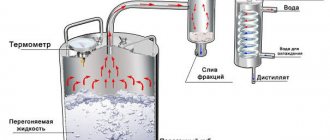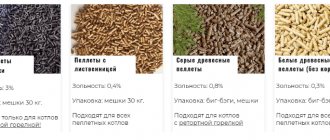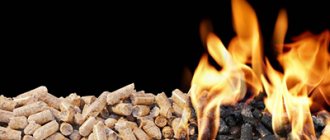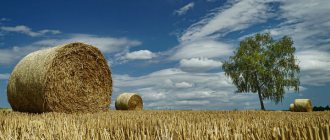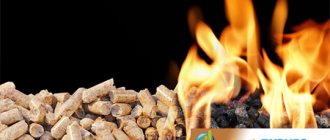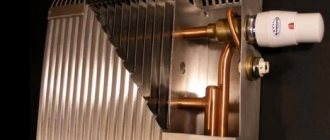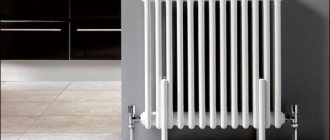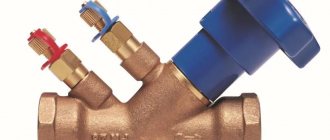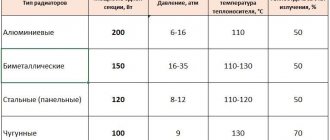Fuel pellets were “invented” more than 60 years ago by the German Rudolf Bunnerman, who lived in America. Having his own sawmill and not wanting to invest money in waste disposal, Bunnerman found an original solution, which today has led to the development of a huge industry of environmentally friendly fuel materials - pellets.
Previously virtually unknown to Russians and residents of other CIS countries, the phrase “fuel pellets” has today become a fashionable term denoting granular fuel produced by waste wood, nuts, husks, straw, peat, etc.
In this regard, equipment for the production of pellets has become in demand on the market. Western countries “took notice” of this topic much earlier and established the production of highly efficient lines for the production of high-quality pellets. It is such certified equipment, or rather, the fuel pellets produced on it, that are easily allowed for export to Europe. The price for such production lines starts from millions of euros. Equipment from a domestic manufacturer makes it possible to launch the production of fuel pellets with lower capital investments.
Fuel pellet production line
What can be made from sawdust
First, let's figure out why wood pellets gained popularity so quickly. So:
- Among all types of solid fuels, they are the most practical and convenient to store, move and load into a boiler installation.
- Pellet boilers do not require intervention more than once a week and are fully automated. The duration of combustion is determined only by the volume of the bunker into which the fuel pellets are poured.
- Sawdust is very common as waste from various woodworking sites and entire enterprises, and after pressing into granules it has excellent calorific value and low ash content.
- There are no various chemical additives in the production of pellets; the fuel is absolutely environmentally friendly.
- Wood pellets can be produced independently, providing yourself with a cheap energy source.
When stored, wood pellets take up less space than firewood or coal; they can be packaged in bags and placed in neat stacks.
Important! Places where pellets are stored must be equipped in accordance with fire safety regulations.
Sawdust and shavings as raw materials for the production of pellets are the most convenient and accessible to many owners of private estates. However, to obtain high-quality granules, certain requirements are imposed on raw materials:
- Softwood makes the best fuel. If you have hardwood or a large amount of bark, they must be mixed to achieve good granule strength and low ash content.
- The shavings should not contain large chips or debris; pellets are made from small sawdust.
- Humidity. Its indicator should be within 12%, otherwise the cylinders may crumble during manufacturing, and when burned, wet biomass will reduce the efficiency of your boiler.
Sawdust that is too wet, which is very difficult to dry or requires more heat than it can generate on its own during subsequent combustion, will be useful for another purpose. For example, the production of briquettes with drying in the open air, as shown in the video.
That is, before starting the technological cycle, shavings and sawdust should be properly prepared. Remember that low-quality raw materials will produce the same hand-made pellets that you will load into your home boiler.
Raw materials
- Sawdust and shavings. Sawdust pellets are considered granules of the first category and are characterized by the lowest ash content in combination with a high specific heat of combustion. They can be used in any heating boilers, including low-power installations. The wholesale cost of sawdust starts from 100–150 rubles/m³;
- Woodchips. For the production of fuel pellets, waste from sawmills, as well as crushed remains of substandard wood, are often used. Due to the presence of bark and roots, this raw material is less valuable, since the content of such impurities leads to an increase in ash content. The average cost of wood chips is from 150–200 rubles/m³;
- Peat. Not only pellets are produced from high-moor peat, but also peat briquettes, which can be burned both in boilers designed for this purpose and in ordinary fireplaces. The ash content of peat granules is within 3%, which allows them to be classified in the second category and successfully used in industrial installations. The average cost of peat is 290 rubles/m³;
- Straw. This raw material for the production of pellets has the highest calorific value combined with an ash content of 4–10%. Therefore, straw pellets serve as fuel mainly in large thermal power plants equipped with specially designed boilers. The cost of straw is from 340 rubles/m³;
- Agricultural waste. Pellets can also be made from waste from processing agricultural crops - sunflower, buckwheat, corn, flax. With an ash content of 2.5–7%, this type of fuel requires the installation of an automatic boiler cleaning system. The cost of sunflower husks is 180 rubles/m³.
The quality of raw materials should be assessed in accordance with several main criteria that determine their suitability for further processing:
- The source material should not contain any solid impurities (stones, sand, metal), debris and non-combustible mineral residues;
- The raw materials must include lignin and organic resins;
- The moisture content of the material should not exceed 35–40% (otherwise the production process is greatly slowed down and drying costs increase).
What are fuel pellets
Before finding out how pellets are made at home or in a production plant, you should understand what this type of solid fuel is. Pellets for heating are cylindrical granules, pressed from combustible raw materials, the diameter of which can be from 4 to 10 mm, and the length is in the range of 15–50 mm.
The process of squeezing pellets through a cylindrical press matrix
What are pellets made of? Various raw materials of natural origin can be used to produce fuel pellets. Thus, the most common types of raw materials from which fuel pellets are made are:
- industrial waste from wood processing enterprises - sawdust and small shavings (pellets made from sawdust and wood shavings are considered the highest quality type of fuel of this type);
- waste from logging and primary wood processing, which includes, in particular, branches, tree bark, dry leaves and even pine needles;
- waste from enterprises engaged in processing agricultural products (in this case, sunflower husks, as well as wheat, rice or buckwheat husks are used as raw materials for the production of pellets);
- peat (granulation or briquetting makes it possible to make peat extracted in a crumbly state more convenient as a fuel material; moreover, a peat briquette, when compared with peat in the form of a crumbly mass, has a higher heat transfer);
- bird droppings, which are produced in large quantities at poultry farms and are suitable for burning;
- certain types of solid household waste, which, using special processing technologies, are converted into inexpensive and fairly energy-efficient fuel briquettes.
At the beginning of the process, wood materials are crushed into smaller fractions
The qualitative characteristics of fuel briquettes (in particular, the degree of thermal output) largely depend on what the pellets are made from.
Depending on a number of parameters by which the quality of pellets is judged, fuel pellets are usually divided into three main categories.
- There are so-called premium pellets, for the production of which highly purified wood waste is used. Fuel pellets of this category, which are easily recognized by their light color, dense and uniform internal structure, are characterized by high heat transfer and minimal ash content. When they are burned, a very small amount of non-combustible residue remains - only 0.5% of the total mass of fuel. The most significant disadvantage of fuel pellets in this category, which make up the vast majority of pellets produced today, is the fairly high cost.
- Fuel pellets of the industrial or industrial category, which, in addition to sawdust, may contain soil impurities, tree bark, foliage and pine needles in small quantities. Pellets of this category, the color of which is darker than that of premium fuel pellets, have a higher ash content, but at the same time provide decent heat transfer. In addition, pellets in this category are affordable. When using industrial grade fuel pellets, boiler equipment requires more frequent preventative maintenance.
- Pellets of the lowest quality are made mainly from agricultural waste. Fuel pellets of this category are characterized by a fairly high ash content (4% or even higher) and not very good heat transfer. Meanwhile, the low cost of pellets of this category makes their use profitable in boiler houses, with the help of which large areas are heated.
Granular fuel can be shipped in bulk for large boiler houses or supplied in bags of various sizes
Pellets made from sawdust, shavings and other natural raw materials are used not only for lighting heating boilers in residential buildings and industrial buildings: they are used to fertilize and mulch the soil. Such granules are also used as adsorbent elements that absorb moisture well.
Where do pellets burn?
Heating boilers using pellets belong to the class of solid fuel boilers. They have a durable body with a combustion chamber and a heat exchanger. The combustion of fuel pellets leads to the release of hot combustion products, which, passing through the heat exchanger, give off heat to it (and it to the coolant).
Pellet heating boiler
Having been “born” back in 1947, pellet boilers have grown significantly in terms of efficiency and “intelligent” development. Pellet boilers today are fully automated systems that can “free” a person from the duties of a stoker for quite a long time (up to a month or more). It all depends on the size of the bunker or warehouse for storing pellets. The self-cleaning function allows you not to “interfere” with the life of a high-quality boiler throughout the entire heating period.
Construction of a pellet boiler
An important factor in the spread of fuel boilers using pellets is their high environmental friendliness. After all, pellets are recycled wood, and their combustion process occurs with minimal release of harmful by-products. In fact, this is a waste-free “production”.
Pellets are an “ecological” product
Pellet boilers, having high efficiency, a long service life, and autonomy (from humans), also have a high cost. But the cost of pellets compensates for the investment in the boiler over several years. The consumption of pellets for heating can be determined from the ratio: to obtain 5 kW of heat, it is necessary to burn 1 kg of pellets. A house with an area of 100 square meters will require 20-25 kg of pellets for its heating.
If necessary, such boilers can be heated with wood, coal, wood chips, straw waste, etc.
Pellet fireplace
The reverse application is also possible. If you have a ready-made stove or fireplace, you can heat it with pellets. Remembering the analysis of the properties of fuel pellets, it can be argued that a pellet stove will have a higher efficiency than when operating from wood.
Main advantages
The active growth in popularity of pellet fuel, observed recently, is explained by a number of its advantages.
- The high environmental friendliness of fuel pellets lies in the fact that when they burn, predominantly water vapor and carbon dioxide are released into the atmosphere, which are not harmful to plants and living organisms.
- Since pellet fuel is highly pyrolyzable, it can be successfully used in highly efficient long-burning fuel equipment. Also, thanks to this quality, the process of loading pellets into a heating boiler can be easily automated, thereby minimizing human participation in the operation of such equipment.
- Due to the compact size of fuel pellets, there is no need to allocate large areas for their storage. In addition, transporting granules does not cause any particular difficulties and, accordingly, does not require significant financial costs.
- Granulation of fuel pellets is carried out without the use of additional chemicals, adhesives and modifiers, which contributes to the purity of such fuel, which does not have an unpleasant odor and does not cause allergic reactions. These characteristics allow you to organize the process of storing pellets even in close proximity to residential premises.
- The thermal output of high-quality pellets exceeds that of many types of natural wood and coal.
- When properly stored, pellets are not subject to processes of internal combustion and decay, which minimizes the likelihood of their spontaneous combustion.
- In many regions where there is a strong raw material base for the production of pellets, and where there are large enterprises producing such products, such pellets are the most inexpensive type of high-quality fuel, which makes it possible to heat both residential and industrial buildings efficiently and at low financial cost. .
Relative cost per unit of thermal energy produced by different fuels
conclusions
Having compared existing prices, we can conclude that the most affordable types of fuel are hardwood firewood
. They burn well, with virtually no residue. If you buy them raw and dry them for six months, then there will be no problems during the heating season. For pyrolysis boilers, you will need two-year-old wood dried under a canopy or drying logs. Wood briquettes can be an expensive alternative.
Pellets
- an excellent fuel, but only if you burn it in special boilers.
Coal
The cost is approximately halfway between firewood and wood briquettes. If you do not take into account the specific smell, then this is a quite decent type of fuel.
Peat briquette
However, despite its disadvantages, it has a price higher than the best firewood. Therefore, if you have to choose between it and coal, you should prefer coal. But the final decision is yours to make.
Text: Vladimir Pavlov.
Photos used from sources: viktrans.com.ua, besplatka.ua, carbonbrief.org, defro.pro
Ask a question to an expert
Production flow diagram
In order to produce fuel pellets that meet all the required characteristics, it is necessary not only to use high-quality raw materials and special equipment for the production of pellets for these purposes, but also to strictly adhere to the technology.
Technological scheme for the production of fuel pellets
The pellet manufacturing process consists of several stages.
- First, the wood raw material is cleaned from foreign impurities and its primary crushing is carried out. As a result of this process, for which conventional crushers are used, wood raw materials are divided into fairly large fractions.
- This is followed by drying, during which the moisture content of the wood raw material is brought to a value not exceeding 12–14%. For drying raw materials, drum or aeration type installations are used.
- After drying, the wood raw materials are subjected to finer grinding, for which hammer-type crushers are mainly used. The output from such installations is fine sawdust or even crumbly wood pulp, reduced to the state of flour, from which the highest quality fuel pellets are produced.
- If, after repeated grinding, the moisture content of the resulting wood pulp does not reach the required minimum value (10–12%), this parameter is artificially increased using steam or ordinary water for this purpose.
- After the parameters of the raw material for the production of fuel pellets are brought to the required values, it is fed to a pressing plant - a pelletizer. In such installations, which may differ from each other in design, the bulk mass is pressed through the holes of the matrix, resulting in the formation of dense cylindrical granules of a certain diameter. Exerting significant pressure on the crumbly wood pulp promotes its spontaneous heating. At the same time, a natural component is released from it - lignin, which has good binding properties. It is this component that ensures the formation of a dense briquette with a stable internal structure from individual particles of crumbly wood raw materials.
- Matrices, in the working cavities of which crumbly wood raw materials are converted into dense fuel briquettes, can be cylindrical or flat. Installations of the first type, as a rule, are produced in a stationary design and are used primarily to equip industrial enterprises. Their design includes a special cutting device that allows the production of pellets of approximately the same length. Flat-type matrix installations, which can be equipped with one or more rollers, are characterized by compact dimensions. This type of equipment is most often used to organize the production of pellets at home or in a small enterprise.
- The finished pellets, the temperature of which, as a result of their spontaneous heating during the pressing process, can range from 65 to 90°, are cooled, dried if necessary, and then packaged and sent to consumers or to a warehouse.
The stages of pellet production are demonstrated in detail by relevant videos that are easy to find on the Internet.
Standards and quality of pellets
Quality Standards
In Europe, a new standard ENplus
for pellets for domestic use and
EN-B
for “industrial” pellets used in industrial enterprises and municipal boiler houses.
Germany initiated the development of new standards. The introduction of a separate quality standard for household and industrial pellets will allow for clear accounting of consumption and control of product quality. New European pellet quality standards compared to the German DIN plus standard
| Quality standards | Units | DIN Plus | EN plus-A1 | EB plus-A2 | EN-B | DIN 51731 | ONorm M 7135 |
| Diameter | mm | 4-10 | 6(±1) | 6(±1) | 6(±1) | 4-10 | 4-10 |
| Length | mm | ≤5хD | 3.15≤I≤40 | 3.15≤I≤40 | 3.15≤I≤40 | 5 x D1 | <50 |
| Bulk mass | kg/m3 | — | ≥600 | ≥600 | ≥600 | — | — |
| Heat of combustion | MJ/kg | ≥18 | ≥16,5 | ≥16,5 | ≥16,0 | ≥18 | 17,5-19,5 |
| Humidity | % | ≤10 | ≤10 | ≤12 | |||
| Abrasion/Dust | % | ≤ 1 | — | — | |||
| Hardness | % | ≥ 97,7 | ≥ 97,5 | — | — | ||
| Ash content | % | ≤ 0,5 | ≤ 0,7 | ≤ 1,0 | ≤ 3,0 | — | — |
| Ash melting point | °C | — | ≥1200 | ≥1100 | ≥1100 | — | — |
| Chlorine | mg/kg | ≤ 0,02 | ≤ 0,02 | ≤ 0,03 | ≤ 0,03 | — | — |
| Sulfur | mg/kg | ≤ 0,04 | ≤ 0,05 | ≤ 0,05 | ≤ 0,05 | ≤ 0,04 | ≤ 0,08 |
| Nitrogen | mg/kg | ≤ 0,3 | ≤ 0,3 | ≤ 0,5 | ≤ 1,0 | ≤ 0,3 | ≤ 0,3 |
| Lead | mg/kg | — | ≤ 10 | ≤ 10 | ≤ 10 | — | — |
| Chromium | mg/kg | — | ≤ 10 | ≤ 10 | ≤ 10 | — | — |
| Arsenic | mg/kg | — | ≤ 1 | ≤ 1 | ≤ 1 | — | — |
| Cadmium | mg/kg | — | ≤ 10 | ≤ 10 | ≤ 10 | — | — |
| Mercury | mg/kg | — | ≤ 0,1 | ≤ 0,1 | ≤ 0,1 | — | — |
| Copper | mg/kg | — | ≤ 10 | ≤ 10 | ≤ 10 | — | — |
| Nickel | mg/kg | — | ≤ 10 | ≤ 10 | ≤ 10 | — | — |
| Zinc | mg/kg | — | ≤ 100 | ≤ 100 | ≤ 100 | — | — |
Equipment for the production of fuel pellets from sawdust
Equipment for the production of pellets from sawdust allows you to quickly set up a business for processing wood waste. As a result, you will not only help enterprises in your region get rid of sawdust, wood chips and other garbage, but you will also be able to earn some money from this, and if you put the business on an industrial basis, then this type of activity may even become your main source of income. At the same time, mini-production of pellets will make it possible to close the shortage of this type of fuel in a particular region, which is not uncommon, because heating with pellets is becoming increasingly widespread in Russia due to its high environmental safety.
Types of equipment for pellet production
The pellet production line can be either industrial or household, designed for the production of mini-pellets for domestic use. Such a line can be driven by a diesel engine, an electric motor or a tractor shaft. In this case, the most common option is the tractor power take-off shaft, since such a power mechanism can provide fairly high productivity in the amount of 200-250 kg/h.
Equipment for the production of sawdust pellets includes:
- tenon cutter, whose main task is to chop wood;
- dryer drum;
- hammer type mill;
- screw mixer;
- press;
- cooler
The approximate cost of such a line could be about 2 million rubles. In this case, a machine for the production of pellets, powered by an electric motor, can only be stationary. This reduces its mobility and requires a special place for it. Carrying out such work can cost several tens of thousands of rubles.
As for the installation, driven by a diesel engine, as well as a tractor, it is highly mobile and can be installed directly in the place where woodworking work is carried out. By the way, in this case, the production of pellets from sawdust will not require additional costs for transporting the material to the place of its processing.
Separately, it is worth noting that stationary industrial-type production lines capable of producing 700-1000 kilograms of pellets per hour will cost about $132,000. This is quite a serious investment, but it will be able to pay off within 7 years.
Mini granulator
Cost from 64 thousand rubles.
Diesel engine pellet press
Cost from 89 thousand rubles.
Pellet press with electric motor
Cost from 100 thousand rubles.
Industrial line
Cost from 1.8 million rubles.
Each type has its own characteristics. For example, a device for electric motors has a certain stationarity, while devices with diesel engines are more mobile.
Example of equipment parts for the production of fuel pellets based on an industrial type line:
Such a line costs about 1,800,000 rubles.
Key elements of pellet lines and their approximate prices separately:
- Wood chipper (wood chipper) - about 180,000 rubles.
- Dryer of raw materials for the production of pellets - from 400,000 to 2,500,000 rubles.
- Granulator - from 50,000 to 1,100,000 rubles. Model OGM-1.5 costs about 1,000,000 rubles.
- Pellet cooler - about 400,000 rubles.
Granulators are divided into types relative to the matrix:
- flat die granulator;
- round die granulator;
- hybrid granulator with flat and round matrix;
Flat Die Granulator
A flat die is a flat metal disk that is made of high quality steel. Its diameter is 100-1250 mm, thickness 20-100 mm. The steel used must be wear-resistant and hardened to 60-60 on the Rockwell hardness scale. As a rule, domestically produced steel 40X is used, or HARDOX 500 and 20CRMN steels are used.
The productive capacity of the granulator directly depends on the diameter of the matrix. For example, equipment with a matrix diameter of 1250 millimeters can produce up to 3 tons of granules per hour.
The round matrix on granulators reaches a diameter of 550 millimeters. It is made from stainless steel with great wear resistance. Such steel should heat up to a hardness of forty-five to fifty kgf according to Rockwell.
When it comes to productivity, it is necessary to differentiate its value from the high-quality preparation of wood and its components. Also, the power of the electric motor is important for high productivity. Manufacturers, as a rule, install a gearbox on the granulator with torque parameters and a gear ratio with high efficiency, which allows the existing electric motor to be used at optimal power.
Such granulators have long been known in the CIS. They produce compound feed. Their series is DG and OGM. But craftsmen have learned to convert them to make fuel pellets. It is necessary to replace the matrix for the raw materials used and the rolling rollers.
The third version of granulators is almost never used in our territories, but is very common in China. The circular matrix is located parallel to the base. Roll out rollers roll the wood into the granulator using their own weight.
Pellet presses driven by tractor power take-off shaft
Cost from 100 thousand rubles.
Types of pellets and their production technology
Pellets, or sawdust granules, are one of the most popular types of secondary raw materials in the future. Thus, in the UK, approximately 600,000 tons of this biofuel are produced annually, and China is planning to reach a production volume of biopellets of 50 million tons by 2022.
If we take the technical side of the issue, then all pellets differ in their composition. For example, they can consist of wood alone or contain admixtures of sunflower husks, bark, straw and other combustible materials. In this case, biogranules are used not only as fuel, but also as cat litter.
Thus, equipment for the production of sawdust pellets, with slight improvement, can be used not only for the production of biofuel, but also for the production of various materials from wood waste. Modernization is also important because equipment for the production of pellets must ensure the ash content of finished fuel pellets within 1.5%.
The production technology of this biofuel includes several stages:
- crushing wood into large fractions using powerful crushing plants (if large wood waste is used);
- drying semi-finished products in drying drums to a humidity level of 8-12%;
- crushing wood pulp into small fractions using hammer mills;
- processing of workpieces with steam or water using screw mixers (this stage is necessary for better gluing of granules during their pressing);
- pressing of pellets and their cooling.
It is worth noting that the pellet production plant creates virtually no waste: all rejected and substandard products can be completely recycled.
Advantages and disadvantages of pellet fuel
- High energy efficiency. Pellets are superior in specific energy intensity to many other types of dry fuel;
- Profitable price. The cost of 1 kW of pellet fuel is lower than the cost of other solid fuel.
- Low ash content. Due to the low ash content of the fuel, there is no need to clean the boiler every day;
- Possibility of automatic feeding. Pellet boilers are equipped with a special storage hopper with automatic pellet supply;
- Ergonomic storage. Packaged pellets take up much less space than firewood. A small room is enough to create a fuel supply for the season.
The disadvantages of fuel pellets include the high cost of pellet boilers. However, every year their prices are gradually decreasing.
Production of pellets from sawdust
Equipment for the production of sawdust pellets can be a great idea for a business or a way to save on heating and water heating in your own home. Fuel prices are constantly rising, and paying utility bills is becoming more and more expensive. That's why many are looking for an alternative. One of them is sawdust-based pellets.
Efficiency of sawdust raw materials
Diagram of equipment for the production of sawdust pellets
Let us give a few examples that will make it clear why such increased attention is paid to the production of pellets.
A ton of pellet granules in terms of energy efficiency is similar to the following parameters:
- 680 liters of fuel oil;
- 500 cubic meters of natural gas;
- 1.5 tons of firewood.
At the same time, you can organize the production of pellets yourself. Technology allows you to do everything at home. The machine itself is also quite simple, so the equipment can easily be placed on your site, in a garage or workshop.
Diagram of the equipment line for the production of sawdust pellets
Before making a machine and setting up the production of special sawdust-based pellets with your own hands, we will tell you what pellets are. This will allow you to decide which production should be targeted specifically in your case.
Pellets are sawdust granules that come in many types. The main difference is in the components used to produce the alternative clean fuel. That's why they happen:
- Pure, without the use of impurities;
- With the addition of straw;
- With tree bark;
- With nut peelings;
- With seed husks.
It is important to understand that the presence of impurities negatively affects the quality of the produced pellet granules, since this contributes to an increase in the ash content of the material. Therefore, the best pellets that you can make yourself are made without additives.
There are two main types of pellet varieties.
- First. First grade products have an ash content of less than 1.5 percent of the total mass of the material. The standard granule diameter of first grade pellets is 6-8 mm. Thermal conductivity indicators are about 4.7 kWh from 1 kg of product. First-grade raw materials can act as high-quality fuel, but at the same time be used as cat litter.
- Industrial. Industrial grade products contain ash in amounts up to 5 percent of the total weight. Mostly similar raw materials from sawdust are used to make cat litters. As a fuel, industrial pellets are only suitable for industrial boilers. The diameter of the granules reaches 1.2 cm, and the thermal conductivity is about 4 kWh. The production of pellets whose ash content exceeds 5 percent is not allowed.
On average, fuel production equipment requires 6 cubic meters of sawdust to produce 1 ton of product.
Features of pellet production
Before you start making sawdust-based eco-fuel with your own hands, you will need to decide on the device that will carry out the production. The technology for producing pellets on all machines is approximately the same. But there are both mini-machines for home production and entire production lines. This is serious equipment designed for mass production of products.
Mini machines and industrial lines differ in the level of pellet productivity and cost. If a home do-it-yourself unit can produce about 100 kg of product at a time, on specialized lines this figure reaches several tons.
But the price is different. Mini pellet machines will cost about 100 thousand rubles for a high-quality, reliable copy. A production line with highly efficient drying and other components costs about 2-3 million rubles.
Sawdust granules, which are later used as fuel or fillers, are produced through several main steps.
- Crushers crush raw materials. In this case, materials of a certain fraction are obtained. At the exit from the crushers, the particles have a diameter of no more than 2-3 mm.
- Next, a special scraper sends the crushed raw materials for drying. Drying is necessary to reduce the moisture level to approximately 7-12 percent. The recommended humidity that drying should provide is 10 percent.
- The resulting raw material goes to a mill, where it is crushed to even smaller fractions - up to 1.5 mm in diameter.
- Screw device and press, together with processing of raw materials with water or steam. In this case, a continuous process of mixing the mass is carried out.
- When the raw material for pellets reaches the required moisture level, the operator presses it with his own hands using the appropriate machine mechanisms.
- To ensure that moisture gets into the drum for mixing sawdust particles, a special dispenser is used.
- If hard, old or low-grade wood was used in the production of pellets, sawdust should be processed with hot steam.
- Matrices are used for pressing pellets. They are flat and cylindrical. The power of the press, depending on the equipment model, can reach 500 kW. Home manufacturing technology requires a much less powerful pressing device.
- Pellet cooling. The next stage is cooling the formed granules. At the exit from the press, their temperature can reach 90 degrees Celsius. The cooling system reduces the temperature and removes excess moisture from the workpiece.
- Pellet packaging. If these are industrial fuel pellets, they are sifted and loaded into trucks and wagons in bulk. When it comes to products of the highest quality, packaging is done in special bulk bags with your own hands. This packaging allows you to preserve the quality of the pellets and not lose their properties over time. Typically, raw materials are distributed into 20 kg bags.
As additional stages of pellet production, the following can be used:
- Raw material purifiers;
- Stone removal systems;
- Units for recognizing and removing metal products;
- Transportation of pellets;
- Warehousing;
- Dosage of pellets.
An important advantage of making pellets from sawdust with your own hands is that the residues obtained as a result of sifting are not sent to waste. They return to the line, where they participate in the re-production of the next batch of raw materials. This makes production waste-free.
Equipment items
Before purchasing equipment and making the first batch of pellets, we recommend that you familiarize yourself with the equipment that should be present on the machine. Home and production lines, in order to improve the quality of DIY production, should include the following components forming pellet equipment.
- Chopper. There are disc and drum ones. Drum machines are equipment for large-scale production, so they can easily chop 300 mm thick logs. For the home, the choice should be made in favor of disk devices. They cope with branches, twigs, and process wood chips up to 3 cm.
- Dryer. Dryers are either drum or aerodynamic. The latter are designed to work with particles whose diameter does not exceed 3 mm. Relevant for large-scale production, equipped with heat generators.
- Pellet granulators. This is a press that forms granules from raw materials. They differ in performance. The most efficient ones produce 3.5 tons of product per hour.
- Pellet cooler. There are louvered and counter-flow types. The former are characterized by a productivity of up to 2 tons per hour, and countercurrent - up to 20 tons in the same time.
- Packaging unit and conveyor. Serve for packaging products in appropriate containers.
Almost all stages of pellet production are automated, which allows you to get maximum profits with minimal costs and raw materials.
Equipment for the production of sawdust pellets with your own hands (price, video, photo) Equipment for the production of sawdust pellets can be a great idea for a business or a way to save on heating and water heating in your own home.
Pellet cost
Let's take the initial data:
- the average cost of industrial pellets in the Krasnoyarsk Territory as of December 2015 is 3,500 rubles per ton (3.50 per kilogram);
- the price of birch firewood is 1,300 rubles per cubic meter, in terms of tons (a cubic meter of dry birch firewood equals 650 kg of weight) is 1,846 rubles per ton (1.85 rubles per kilogram);
- the calorific value of birch firewood is 10 MJ/kg;
- The calorific value of wood industrial pellets is 18 MJ/kg.
In order to obtain 100 MJ of thermal energy, you need 10 kg of firewood (100/10), that is, 18.50 rubles, or 5.5 kg of pellets (100/18), that is, 19.44 rubles. The difference in cost is 1 ruble per 100 MJ. Moreover, it is necessary to note the undoubted advantages of pellets with an ash content of 1.5% over firewood with an ash content of 10%, the difference is obvious. It should be taken into account that the pellet market is growing dynamically, and with an increase in supply, the price will undoubtedly decrease. By the way, pellets can be made independently from agricultural or wood waste. Read below how.
How to make pellets from sawdust, straw or husks with your own hands
First of all, it is necessary to carefully calculate the feasibility of this event. If the raw materials for the pellets are free or the owner got them for next to nothing, then the implementation of the idea will be profitable.
To produce pellets, two components are needed: raw materials and equipment. Sawdust, husks or straw are also not suitable, they need to be prepared first:
- Only softwood will make it possible to produce high-quality pellets. Sawdust from hard types of wood will have to be mixed with softer ones, otherwise granules will not form - the pellets will crumble into powder, and when burned they will produce a large amount of ash.
- The humidity of sawdust plays an important role in the production of pellets - it should be at the level of 12%. Wetter sawdust will have to be pre-dried (straw and husks, as a rule, are initially well dried), and overdried raw materials must be moistened, otherwise the granule will not form.
- Sawdust of a large fraction must be crushed, since sawdust or straw, previously cut into small pieces, is fed into the granulator.
Based on these requirements, it is easy to determine the number of pieces of equipment in a production line for making pellets with your own hands:
- crusher for primary grinding of branches, wood chips and bark;
- drying or drying chamber;
- another crusher for finer and better grinding of sawdust;
- humidifier for sawdust;
- granulator;
- cooler for finished pellets.
Each of these devices needs to be described in more detail, but it is the working tool that deserves the most attention - a granulator or a press for squeezing out granules.
Pre-treatment of sawdust
Before pressing, raw materials for pellets must go through several stages of preparation:
- primary grinding, during which branches are cut, bark, twigs and other hard and large fragments that can be caught in sawdust are broken. For these purposes, it is necessary to use a crusher capable of crushing sawdust to a size of 1.25 cm³. You can avoid this stage if you use high-quality sawdust from furniture or carpentry, straw or husks.
- Sawdust must be dried in special chambers with high temperatures. The moisture content of the material after this stage should not exceed 8-12%.
- In small hammer-type crushers, dried sawdust is crushed to a fraction of 1.5 mm. The straw is cut with special scissors.
- In order for the sawdust or hay powder to clump, it must be moistened again. Sawdust from soft wood is irrigated with water, while sawdust from oak or beech must be treated with hot steam.
Attention! Making pellets from straw is much easier than making pellets from sawdust. The straw does not need to be dried; it is chopped with scissors rather than crushers, and, due to its softness, the straw is much easier to press through the holes of the granulator. Less equipment, less power spent on granulation - the result is lower costs for the production of pellets.
Pressing of raw materials
The granulator is the most important and most expensive piece of equipment for the production of fuel pellets. This device can be purchased, but craftsmen with access to a lathe and welding machine can make a pellet press with their own hands.
There are several types of pellet granulators:
- A screw press resembles a regular meat grinder - the same shaft moves inside it, and a mass of crushed sawdust is pressed through a matrix with holes. It’s not difficult to make such a press with your own hands, but its power may not be enough for sawdust granulation; a screw granulator is more suitable for straw and husks.
- Flat die presses are the most popular type of equipment in home pellet production. Sawdust is poured into a hopper, at the bottom of which there is a matrix with holes; two toothed cylinders roll along this flat matrix, which press the sawdust to the holes, pushing them through and forming granules. It is quite possible to make such a granulator yourself, you just need to know how to use a milling and lathe. There are press parts for sale, which allows you to simply assemble the device from ready-made parts. It is enough to purchase an electric motor and a metal matrix, after which you need to assemble a pellet pressing machine from all the parts.
- Presses with a cylindrical matrix are considered the most productive, therefore, they are most often used on an industrial scale. The principle of their operation is the same as the previous granulators, only the toothed rollers are located inside a large cylinder with holes, and roll along its walls, pressing a mass of crushed sawdust. There is a knife installed outside that cuts the granules to the required length.
Advice! Home sawdust granulators, as a rule, are not very powerful, so they work quite slowly. In order not to stand near the hopper all the time and not fill up the raw materials, you can make a screw conveyor along which the sawdust will move to the granulator hopper at a certain speed.
Final stage
During the pressing process, sawdust is heated to 70-90 degrees; in this form, the granules are very brittle, they can easily crumble and deteriorate. Therefore, the pellets must be cooled immediately after leaving the granulator. To do this, they are placed on flat pallets and blown with cool air or left to cool in natural conditions.
After cooling, the granules become hard and are no longer so easy to break. Now the pellets need to be sifted to separate unformed parts, dust and fine wood powder - all this causes the appearance of excess ash on the walls of the boiler.
Screened sawdust pellets can be placed in plastic bags and stored until the next heating season.
Important! In the room where sawdust pellets are stored, fire safety standards must be strictly observed, since the material is highly flammable.
Comparison with other fuels
The use of this fuel is beneficial from various points of view. And environmentally friendly.
For comparison, you can conduct an oral analysis:
- Like other types of fuel, the use of wood pellets can be done in a fully automated manner.
- Their high calorific value makes them stand out against the background of ordinary chips and lump wood.
- They burn almost completely, unlike wood and coal, leaving no ash that can clog the air ducts and boiler burner.
- High filling capacity and convenient packaging allow them to be transported in any container.
- Storage requires less space than the same firewood.
- They are not explosive and will not ignite during any handling; this sets them apart from fuel oil and liquid fuel.
Economic components:
- Price stability, not tied to a jump in the dollar.
- Also, the economic component is highlighted by the fact that over long-term use, pellets will not clog the boiler system and you will not need to spend money on purchasing new burners or carry out expensive cleaning of the system, as when using fuel oil.
Environmental benefits:
- Unlike other types of fuel, they can be stored in close proximity to housing, without any odors or harm to health.
- The granules do not contain allergic spores, only a natural product.
- Completely harmless to the environment.
Speaking about the amount of heat you produce, in relation to other types of fuel, the following figures are obtained: a ton of granular fuel releases 5000 kW of energy during combustion.
The same amount is released by other materials in the following quantities:
- diesel fuel – 500 liters;
- fuel oil – 685 liters;
- wood – 1600 kg;
- gas – 475 cubic meters;
Other production costs
In order to correctly calculate the profitability of this type of business activity, you need to take into account several more important nuances. In this case, it is assumed that the working day is 8 hours long, and the month consists of 24 such days (including weekends and holidays). In addition, in the calculations (based on the experience of similar enterprises), the total costs for wages of hired workers, water, electricity, as well as other production and operating costs are assumed to be 30 percent of revenue.
How to distinguish high, premium quality pellets from substandard fuel?
When purchasing pellets, you need to pay attention to:
- the surface of the material must be smooth, shiny, without signs of deformation (swelling and microcracks);
- diameter (this parameter is established by the standards, the minimum value is 4.00 mm, the maximum is 10 mm, also standard are fuel pellets that have a diameter of 6.00 and 8.00 mm, please note that a pellet boiler operates on pellets of a certain fraction);
- length (this parameter should be about 20.00 - 30.00 mm, this is the optimal value, although the equipment can work on pellets with a length of over 50.00 mm);
- smell (the granules should have a slightly sweet smell of freshly prepared glue, this is a clear sign of excellent quality);
- color (it is important to remember that the highest quality pellets are white or slightly cream-colored, agropellets are predominantly dark, and in wood pellets, dark color indicates that bark, other impurities have been added, or wood species have been mixed);
- dust (there should be a minimum amount of dust on pellets, so it is better to buy fuel in sealed packaging);
- impurities (the presence of non-combustible impurities in the granules themselves can only be checked by burning them and determining the residue in the form of solid particles).
Sales abroad
The pellet export market deserves special attention. In developed European countries, the consumption of this particular type of fuel is the most common. Most municipal and private buildings, as well as industrial boiler houses, are equipped with boilers operating on it.
In this regard, the Western European region is now considered the largest consumer of pellets. Currently, the share of domestic granular fuel in this market is very small. According to economists’ calculations, over the next ten years the need for this type of fuel here may increase tenfold, which we can try to take advantage of.
Features of heating with pellets
In order to use pellets as fuel more efficiently, you need to purchase a special boiler. Pellet boilers operate in an automated mode: fuel pellets are stored in special containers - pellet bunkers, from which they are fed into the boiler using an auger.
If you want to save money and buy gray rather than white pellets, we advise you not to buy a large batch of fuel at once: not all burners can handle them. First, buy a bag and test it. If the boiler is working normally, you can purchase a larger batch. Do the same with agropellets: first test the operation of the boiler with a small amount. But besides the ash content, there may be other problems: these granules do not tolerate transportation well, so already at this stage you will end up with a lot of waste. So it turns out that heating with this fuel, even if the boiler can handle it, is advisable if the production is somewhere nearby.
The ideal pellets for boilers are white. Their composition is usually homogeneous, and the ash content is low. Due to the characteristics of the raw material, the surface of such granules is dense, they crack and crumble less, and withstand transportation better.
